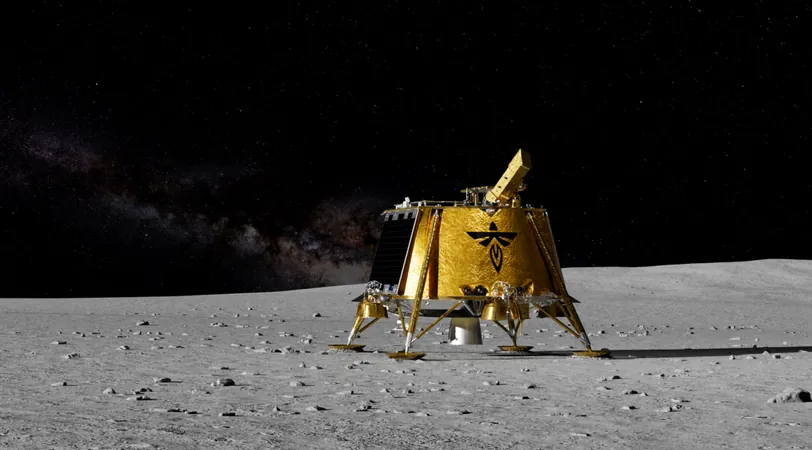
Exciting News! The First U.S. Mission to Mare Crisium – Get Ready for Blue Ghost Mission 1!
2025-01-06
Author: Rajesh
Get ready for a groundbreaking moment in space exploration!
Near the Moon's eastern limb lies Mare Crisium, or the Sea of Crises, a vast lunar plain with a rich geological history dating back approximately 3.9 billion years. This 460-mile-wide (740 kilometers) expanse, surrounded by rugged mountains, isn't just an alien landscape; it holds tantalizing clues to an active volcanic past and is littered with craters shaped by ancient lava flows. Amidst its dark surface rests a solitary landmark: Mons Latreille, a four-mile wide (6.4 km) mountain, which adds a touch of intrigue to this already captivating region.
Blue Ghost Mission 1 is Set to Make History
Soon, a robotic lander known as Blue Ghost will touch down in this enigmatic region, carrying an array of 10 scientific instruments as part of NASA’s Commercial Lunar Payload Services (CLPS) program. Slated for a mid-January launch window, Blue Ghost—fondly dubbed "Ghost Riders in the Sky"—aims to be the first U.S. lander to explore Mare Crisium.
But why is Mare Crisium so special? At over 68,000 square miles (176,000 square kilometers), it rivals the entire land area of Oklahoma, and it has long been a focal point for lunar exploration. Sixty years ago, the Soviets made an attempt to land a robotic probe called Luna 15 here, but it tragically collided with a mountain during its descent. Subsequent missions had mixed results, with Luna 24 finally succeeding in returning lunar soil samples in 1976, hinting at the existence of water on the Moon.
The Innovative Blue Ghost Lander
Developed by Firefly Aerospace, a burgeoning company from Cedar Park, Texas, the Blue Ghost lander is the culmination of recent advancements in space technology. Standing 6.6 feet (2 meters) tall and with a wingspan of 11.5 feet (3.5 meters), it can carry a payload of about 330 pounds (150 kg). The lander features sophisticated communications systems and is powered by solar panels generating 300 watts of energy for missions lasting up to 60 days.
After multiple design reviews and a successful assembly, Blue Ghost is now primed for its journey to join the ranks of lunar exploration missions targeting a launch window opening in mid-January. Once it takes off via a SpaceX Falcon 9 rocket, it will take several weeks to make its way to the Moon, including a series of health tests and preliminary checks.
An Ambitious Descent and Groundbreaking Science
The landing phase will be thrilling—the lander must descend from a 60-mile (100 km) orbit, navigating with precision using its terrain-relative navigation system. Firefly has meticulously practiced landing procedures on various simulated surfaces to ensure the craft can handle any irregularities upon touchdown.
Once on the lunar surface, the Blue Ghost mission will truly begin! Over a 14-day science window, it will deploy instruments designed to unveil the mysteries beneath the crust and gather critical data for future human missions. These instruments include:
- Texas Tech University's drilling technology to measure internal heat flow.
- A global navigation satellite system (GNSS) experiment aimed at mapping lunar coordinates with Earth-based GPS signals.
- A dust-removal electrodynamic shield to test techniques for keeping essential equipment clean in the harsh lunar environment.
What's Next for Blue Ghost and Beyond?
This monumental mission is just the beginning. Firefly Aerospace is already planning future missions, including a follow-up expected to launch in 2026 that will land three payloads on the lunar farside, showcasing their commitment to expanding lunar exploration.
As we brace ourselves for the launch of Blue Ghost Mission 1, it's clear that this ambitious venture is not only an exciting step forward in lunar research but also marks a pivotal moment for the future of space exploration. Stay tuned, space enthusiasts—Mare Crisium awaits its first American visitor!
 Brasil (PT)
Brasil (PT)
 Canada (EN)
Canada (EN)
 Chile (ES)
Chile (ES)
 Česko (CS)
Česko (CS)
 대한민국 (KO)
대한민국 (KO)
 España (ES)
España (ES)
 France (FR)
France (FR)
 Hong Kong (EN)
Hong Kong (EN)
 Italia (IT)
Italia (IT)
 日本 (JA)
日本 (JA)
 Magyarország (HU)
Magyarország (HU)
 Norge (NO)
Norge (NO)
 Polska (PL)
Polska (PL)
 Schweiz (DE)
Schweiz (DE)
 Singapore (EN)
Singapore (EN)
 Sverige (SV)
Sverige (SV)
 Suomi (FI)
Suomi (FI)
 Türkiye (TR)
Türkiye (TR)
 الإمارات العربية المتحدة (AR)
الإمارات العربية المتحدة (AR)